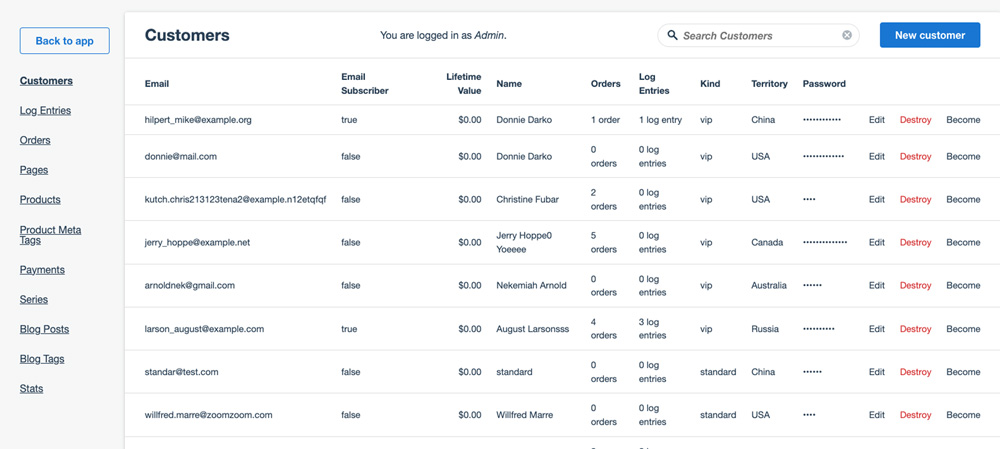Avo vs. Administrate: which one should I choose?
Ok, we are a little biased: we think Avo is a perfect match for Rails developers and founders that want to make their admin panels an afterthought.
However, both Avo and Administrate allow you to create panels quicker than you would by doing everything from scratch.
They both accelerate the process from rails new your_awesome_idea to an application that can be enjoyed by users and admins alike.
However, the comparisons between Avo and Administrate stop there: Avo has a great deal of features that Administrate doesn't and those can make your life easier when building apps.
Let's dive deep between these two solutions to help you decide which one is better for you.
Beyond basic scaffolding
Administrate was released almost 10 years ago.
Back then, if you were a Rails developer, you had a couple of choices to build admin panels faster than by scaffolding and customizing output.
Most of those alternatives were cumbersome to customize and tended to become a mess pretty quickly, especially if you needed to keep things up to date.
Administrate came to try and replace those solutions with a simple promise: build your admin panels by running scaffolding that's somewhat configurable.
But, that's hardly what you need to build anything but the simplest rails apps or admin panels.
Every Rails application starts simple and gains complexity over time with piling user and stakeholder requirements.
When that time inevitably comes, that's when Administrate shows its shortcomings and a solution like Avo shines.
Avo is built to get out of your way while you create value for yourself or your company developing awesome Rails applications.
Administrate's shortcomings: the elephant in the room

Avo is built on top of the shoulder of giants, we respect the pioneers that came before our time and Administrate is one of them.
Even though we didn't base Avo on Administrate's features or code whatsoever, we came after them and respect the path they paved for us.
However, Administrate has a lot of shortcomings that we decided to solve when writing Avo.
-
Field options are limited: whatever it is you build with Administrate, you only get a handful of fields from default. This means that you will quickly find yourself creating your own fields for basic use cases.
-
Documentation is limited: Administrate's documentation covers their most important building blocks (dashboards, fields, controllers, etc) but it lacks the depth and scenarios we developers love to see.
-
Not actively maintained: Even though it still get's some maintainance here and there, Administrate is still at pre 1.0 and the future doesn't look so promising regarding improvements or updates to the library.
-
Born and stuck in a previous Rails era: We all know and love the benefits of the Rails way: rapid development and quick results as long as we stick to what Rails provides us by default. Administrate was born in a previous Rails era where goodies like Hotwire or Stimulus weren't yet created so any integration with Hotwire, Turbo or Stimulus is on you.
-
Depends on jQuery: Even though jQuery was and still is a huge part of the web, there's a not neglibile amount of developers that would rather avoid jQuery nowadays replacing it with ES6 to reduce dependencies.
-
Depends on a disperse and non active plugin ecosystem: External contributors created plugins for Administrate to solve the need for customization. Sadly, most of those plugins are abandoned as of today, making them unusable without some scrutiny and changes.
-
Not an ideal user interface: This might be a subjective opinion but admin panels are not only used by pragmatic developers. Having a nice interface that communicates intent clearly is something that will make you more productive and can't be taken for granted nowadays.
Avo: everything you get with Administrate, but better

Everything you get with Administrate you get with Avo plus a ton more.
Want to get a blog up and running in 20 minutes? Avo's got your back.
You know how to build a simple blog using Rails scaffolding but you're having second thoughts about building a booking application using Rails? Avo's got your back.
You're a startup founder with limited founding but limitless creativity and determination? Avo's got your back.
Avo is built by a team of driven people that've already used every Rails admin panel in existence and experienced the pain that comes with customizing them to the needs that arise from building real Rails apps used by thousands of users around the world.
Also, Avo is constantly being improved, basing our roadmap and features on feedback given by real users with real needs.
This is what Avo's free plan can contribute to your development flow
-
A vast variety of fields: whatever it's you build with Administrate, you only get a handful of fields from default. This means that you will quickly find yourself customizing code and looking at internals to suit your needs. With Avo you get a lot of fields to help you build your backoffice: text, WYSIWYG textareas with Trix or Tip Tap, password, number, boolean, datetime, taglist, enum, file, image, sound, video, etc.
-
Development speed through sensible defaults: following our best practices can easily get you at 10x development speeds vs your typical Rails scaffold or manual admin set-up.
-
Current Rails best practices: Avo uses Hotwire and Stimulus to bring a highly interactive experience to the table without the need to write boatloads of front-end code.
-
Most common admin features out of the box: It doesn't matter if this is your first or n-th admin panel. Avo can help you build solutions way faster than other alternatives by providing you with the right features at the right time.
-
Excellent documentation: Avo's documentation is one of a kind. We put a lot of effort into documenting even the smallest detail about our product so users can enjoy them with minimal support. If your experience is different, please shoot us an email so we can improve our documentation.
-
Minimal configuration to achieve what you want: we let you customize your admin panel but don't require extenous amount of configuration to do so.
UI is not about the looks, it's about experience

User interfaces are not important because of beauty or aesthetics.
They matter because, good design can help users reach their goals faster by effectively communicating what they do.
That's why Avo looks good by default: we sweat on the little details so you don't have to. That means that you, as a developer, don't have to spend on a designer to get beautiful and usable design. This is free with Avo.
Hey, we're not saying our interface is the slickest and most beautiful ever, but it does its job very well and it helps developers and admins be much more efficient from the get go.
Even though most apps are backed by a database, this doesn't mean that your admin panel should be a glorified database browser.
We've built dozens if not hundreds of admin panels and they almost always start as a way to visualize what's in the database. However, they inevitably grow in complexity: more features, different ways to present information, use cases that nobody thought about at the beginning, etc.
That's why Avo supports many advanced use-cases that enable developers to build complex flows to handle different scenarios that may not seem obvious when you're starting out but that frequently present themselves as you're building admin solutions..
As a consequence, both your admin panel and your application end up being better and you end up saving time and money in the process.
How fast can I build a real application using Avo
Naturally, it depends on the type of app you're building.
If your app, like 90% of the apps, is content centric, you can at least triplicate your development speed using Avo.
Every feature is actually designed to make you more efficient in delivering value to your customers instead of having to write yet another CRUD related view to handle the resources that your application needs.
Speed to market, a must when releasing a new product, is where Avo can help you the most: you can easily get to market in days or weeks instead of months.
Plus, you can rest assured that when the time to customize your admin panel, Avo gets out of the way and lets you personalize your experience as you wish.
I get it, but why is Avo a paid product?
I know, you're probably wondering about the fact that Avo is not 100% a free product.
Even though we have Avo's community license. which is free, some features from Avo are not free.
Most Rails admin libraries are free so you probably wonder: why do these guys think they can charge me actual money to use an admin panel?.
The thing is, you don't really need Avo's premium features to build a great product.
There's plenty of features in the Community version of Avo to help you reach your goals while you're starting with your projects.
However, you can easily get way more value than what you pay for Avo if you consider development time in your purchasing decision.
We've been tirelessly working on Avo for the past 3 years and that shows: considering hiring costs, not even the best Rails dev out there can build a fraction of Avo's features for the price of our Pro license.
Not only that but you get features and support that lasts as long as your license plus continuous development and improvements check our roadmap to see what's ahead for Avo in the near future.






